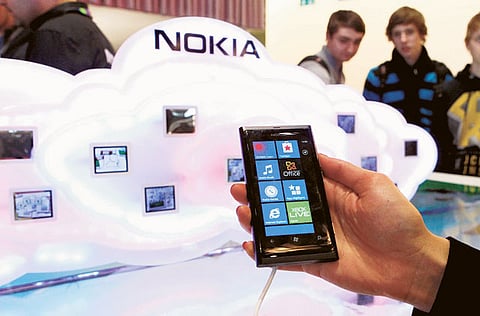Nokia retains top spot
iPhone, Blackberry not the smartphones of choice, data show

Dubai Contrary to public perception that the iPhone and BlackBerry lead the pack in the region as the preferred choices for smartphone buyers, Gartner figures show that Nokia sold more smartphones than any other manufacturer last year.
Gartner gathers its numbers from each phone manufacturer independently and then crunches the numbers for analysis.
"Nokia is still the leader in smartphones as well as all total handsets in the region due to the strong brand recognition it has enjoyed over the past years and good value for money it has to offer," Zimmermann said.
Sophisticated customers
Tom Farrell, Vice-President of Nokia Middle East, said Middle East customers are very sophisticated about mobility and they love innovation and the latest gadgets.
He said: "We plan to introduce and bring to markets new and more affordable products with more modern user experiences with Windows Phone in 2012."
Chris Jones, Vice-President and Principal Analyst at research firm Canalys, said: "The greater availability of smartphones at lower price points has helped tremendously, but there has been a driving trend of increasing consumer appetite for internet browsing, content consumption and engaging with apps and services on mobile devices."
Nokia sold 95.83 million devices in smartphones and feature phones to lead the market, more than all of its competitors combined. Regionally, Samsung was ranked second in sales and Research in Motion coming in third.
As for regional smartphone sales only, Nokia was still the dominant manufacturer followed by Research in Motion and Android taking third spot.
Zimmermann said analysis predicts, however, that Nokia's Symbian market share will erode in coming years as it moves to the Windows platform.
She said Nokia has introduced Microsoft Exchange and maps on S40 devices and these are doing very well, as well as its Asha products. This may put pressure on RIM.
"Android is gaining ground in this region thanks to the many device manufacturers who are backing this platform."
Android-based phones are expected to grow stronger in the market as the platform "is moving down the price-tiers in this market as the device vendors who support Android want to push their phones to the mass market", she said.
Samsung's success and focus on Android have contributed substantially to the growth of the platform, Jones said, adding that other vendors, such as Sony Ericsson, Huawei, Motorola, LG and HTC, have also seen significant growth in their Android volumes over the course of 2011.
Both analysts said in the same voice that Samsung had done a good job with their branding and spend big on marketing activities, and its strong product portfolio — particularly the Android-based Galaxy range — performed well. People who know what the iPhone is also know what Galaxy is.
This year in few regions, Zimmermann said unit prices of Android phones have reached $75 (Dh275). ZTE and Huawei are really pushing prices of Android phones down. Vendors are not really keen on Windows handsets and they are focusing on Android.
Nokia's first handset to run on Windows platform will be launched soon in the region.
It has already been launched in Africa. She said the reason for not launching it in the Middle East is due to the lack of Arabic support. Nokia has a strong brand loyalty in the Gulf countries.
White-box products
In addition to the strong growth of smartphone sales, she said, increasing sales of white-box products drove sales of mobile phones upward once again.
"For 2011, strong shipments of white-box manufacturers from China and India continued to expand their reach beyond their boundaries. White-box manufacturers sold 10-12 million units," Zimmermann said.
Strong demand for smartphones continues to punch in all the right numbers for growth in the mobile handset category in the Middle East and Africa (MEA).
Around 200 million handsets are expected to be sold this year, of which 50 million are expected to be smartphones, mainly driven by the Android platform.
In 2011, end users bought 180 million compared to 155.87 million in 2010.
Out of the total 180 million, 30 million were smartphones compared to 16.41 million in 2010.
Full-year figures for the region are not released publicly and were provided by the Gartner office in Munich at Gulf News' request.
"The region had a strong growth in the fourth quarter. The second half was also very strong with smartphones registering 20 per cent quarter-on-quarter growth," Annette Zimmermann, Principal Analyst, Consumer Markets & Technology at Gartner, Inc, told Gulf News.
Apple failed to increase its market share in the region despite the launch of the iPhone 4S. It is still at the high end of the smartphone segment.
In North America, she said older models are still sold by carriers, but in other regions, carriers are only selling the latest models. Apple is very strong in North America and this was an exception.
The fourth quarter was an exception due to the launch of the iPhone 4S and Apple's market share will fall in 2012. Apple had a market share of 10 per cent for the full year.
"Apple is the only company which is able to differentiate itself from the rest of the vendors. 2011 was a good year for Samsung, but they need to look at how they can differentiate this year like cloud platform and services.
Different vendors are working on cloud. Sony and Microsoft are working on their devices. This year is not good for cloud. That will take some more time," Zimmermann said.
Sign up for the Daily Briefing
Get the latest news and updates straight to your inbox



